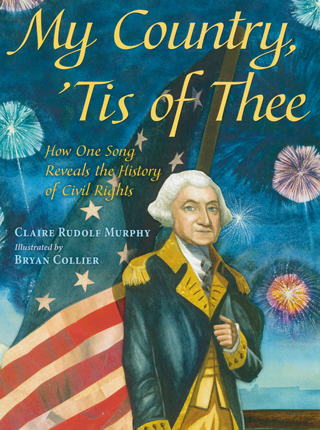| My country, 'tis of thee : how one song reveals the history of civil rights Author: Murphy, Claire Rudolf | ||
| Price: $22.58 | ||
Summary:
More than any other, one song traces America's history of Patriotism and protest.
| Illustrator: | Collier, Bryan |
| Accelerated Reader Information: Interest Level: LG Reading Level: 5.50 Points: .5 Quiz: 166656 | Reading Counts Information: Interest Level: 3-5 Reading Level: 8.50 Points: 3.0 Quiz: 63928 | |
Common Core Standards
Grade 2 → Reading → RI Informational Text → 2.RI Key Ideas & Details
Grade 2 → Reading → RI Informational Text → 2.RI Craft & Structure
Grade 3 → Reading → RI Informational Text → 3.RI Key Ideas & Details
Grade 3 → Reading → RI Informational Text → 3.RI Integration of Knowledge & Ideas
Reviews:
Kirkus Reviews (05/01/14)
School Library Journal (00/05/14)
Booklist (06/01/14)
The Bulletin of the Center for Children's Books (A) (00/07/14)
Full Text Reviews:
School Library Journal - 05/01/2014 Gr 5–7—A familiar patriotic song culminates in a hymn to "Great God Our King," having long ago originated as a tribute to England's King George II. Through two centuries, many different texts were used by groups for whom freedom didn't ring. Murphy's subtitle introduces this collection of variants. The chronological string of historical points begins in 18th-century England and moves through protests of the colonists, the Revolutionary War, and subsequent lack of freedoms and full citizenship for women, slaves, Native Americans, and people of color until well after the Civil War. Double-page entries include a short bit of history and a related verse of a protest song set against Collier's watercolor and collage scenes and portraits of individuals and groups. The view is most often somber, with dark and neutral tones occasionally brightened with a bit of deep blue. The presentation culminates with Marian Anderson's 1939 Lincoln Memorial performance upon being shut out of Constitution Hall, the rise of Martin Luther King, Jr., and Aretha Franklin's singing at the inauguration of Barack Obama. Finally, readers are invited to "Write a new verse for a cause you believe in. Help freedom ring." The invitation is laudable, and some of the songs are clear and compelling. Others seem quaint or even murky for a young audience: "Let Freedom's voice prevail,/And draw aside the veil,/Supreme Effulgence hail,/Sweet Liberty." The book concludes with brief notes about each entry and the music and verses of "My Country 'Tis of Thee." The sketchy outline of civil rights history could serve as an introduction for some readers or classrooms. Creative music teachers might also use it to explore the larger realm of protest songs.—Margaret Bush, Simmons College, Boston - Copyright 2014 Publishers Weekly, Library Journal and/or School Library Journal used with permission.
Booklist - 06/01/2014 This unusual picture book traces the history of the song that is usually referred to by its first line, My country, ’tis of thee (the song’s true title is America). Murphy suggests that the changes made to the lyrics in different periods create a narrative of civil rights in America. Originally an English song from the 1740s (God Save the King), it inspired new, more revolutionary verses as colonial America moved toward independence. Later, activists adapted the song to promote a variety of causes, including the abolition of slavery, voting rights for women, workers’ rights, and civil rights for African Americans. The text creates a sweeping sense of history, culminating with Aretha Franklin singing America at President Obama’s inauguration and urging children to write a new verse for a cause you believe in. Collier’s atmospheric collages of paintings and photos create richly textured effects as well as some iconic portraits, while the settings and dress in the artwork will help readers envision the swift shifts from one period to the next. An intriguing new take on a beloved patriotic song. - Copyright 2014 Booklist.
Bulletin for the Center... - 07/01/2014 The titular song (more formally entitled “America”) was once a contender for the United States national anthem. The tune was nixed by citizens who couldn’t bring themselves to elevate a melody so closely associated with the British monarchy, but its 1831 Samuel Francis Smith iteration nonetheless remains a highlight of the patriotic canon. In this picture book account, Murphy revisits pivotal moments-social, political, and martial-in which the familiar song was co-opted and re-lyricized as a partisan theme song. Revolutionary War soldiers changed “God Save the King” to “God Save the Thirteen States”; abolitionists sang “My country, ’tis for thee, Dark land of slavery, For thee I weep”; labor activists lashed out against Industry with “Land of the Millionaire; Framers with pockets base; Caused by the cursed snare-The Money Ring.” The examples here demonstrate the versatility of the song itself and the power of a singable tune to rally supporters around a cause. Many of the verses, however, incorporate archaic language and period references that require explanation, and that illumination is consigned to endnotes, an arrangement that will leave readers who routinely ignore end matter reaping the consequences, or force diligent readers to flip to the back of the book after each spread. Collier’s mixed-media illustrations, sober in tone and rich in symbolic imagery, are worth lingering over and will add dimension to classroom discussions arising from a shared reading of this title. Annotated source notes direct children to resources they are unlikely to access, but lists of “Musical Links” and “If You Want to Learn More” will indeed be helpful in connecting readers to songs and recordings, many online. The music and complete lyrics to the 1831 song are also included. EB - Copyright 2014 The Board of Trustees of the University of Illinois.



